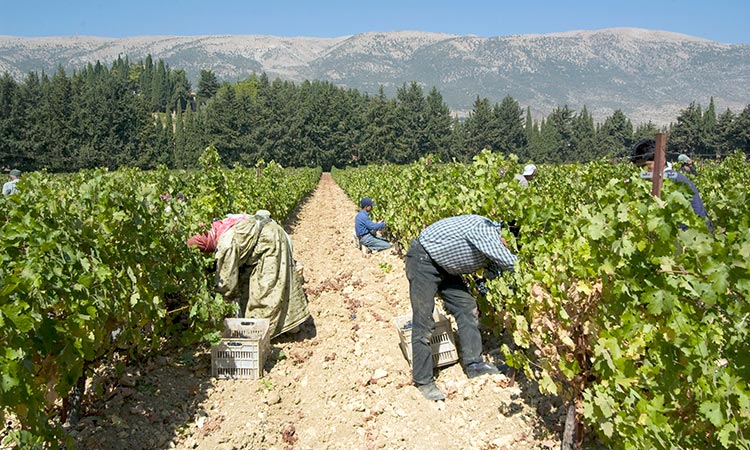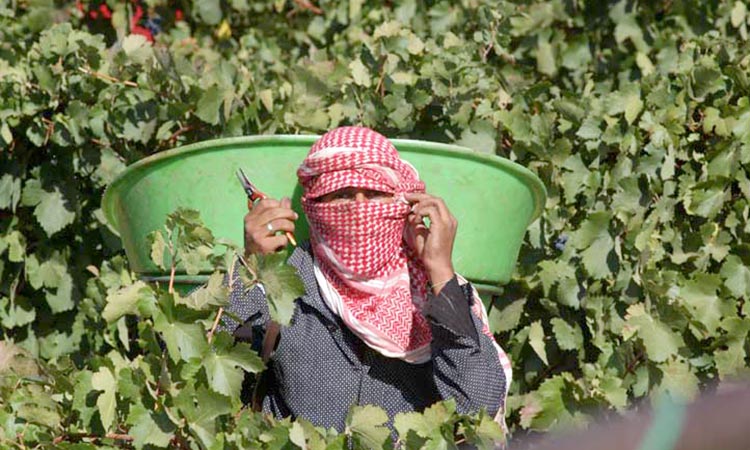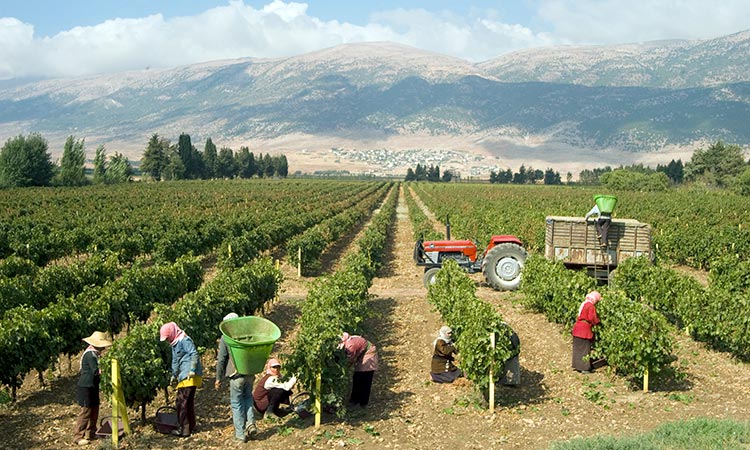If you ever need a new nose for your 1983 Mercedes 230E, Chtaura in
the Bekaa Valley is the place to go. It’s full of workshops keeping
Lebanon’s extraordinary range of 1970s and ‘80s European and American
cars on the road. Yet, while this area looks like the last
place you’d expect to find a world-class winery, at the edge of town,
set back from the road, is a fine collection of 19th-century buildings
that make up Domaine des Tourelles.
At one point, this winery would have been somewhat isolated, but
gradually the suburbs of Chtaura have engulfed it. The surrounding
air is heavy with pollution and the roadside strewn with rubbish.
Noticing my attention on these unsightly piles, Michael Karam,
our Anglo-Lebanese guide — and probably the world expert on Lebanese
wine — mutters that “Lebanese people always talk about their country
being the most beautiful in the world, but they’ve ruined it.”
A Study in Contrast

From Domaine des Tourelles, we take the road south towards Kefraya,
where suddenly we’re among vineyards dominated by snow-capped mountains.
Chateau Kefraya, a fortress-like building dating back to the 1940s
that’s surrounded by pine and cedar trees, could easily pass for
Switzerland. It’s hard to believe the war in Syria is only 12 miles
away
Local Pride
The Lebanese – long time consumers of whisky, arak and French wine – are
“slowly waking up to pride in Lebanese wine,” says Ixsir’s Hady Kahale.
Internal tourism is growing too. Kefraya gets 50,000 visitors per year.
There’s clearly a lot of money around, as evidenced by state-of-the-art
winemaking equipment at Kefraya and Ixsir.

According to Kefraya’s Edouard Kosremelli, wine is Lebanon’s highest
profile export, and benefits the whole country. “The wine industry has a
trickle down effect to many hundreds of families in the Bekaa, the vast
majority of whom are Muslim,” he adds. Faouzi Issa from Tourelles
points out that not even winery owners are all Christian, citing, for
example, former Druze warlord Walid Jumblatt, who’s now an investor in
Chateau Kefraya.
In downtown Beirut, next to a derelict 19th century building, farmers
from all over the country sell produce at the Souk el-Tayeb market.
Kamal Mouzawak, the market’s organizer, shows me Christian wine
producers alongside Shia women in headscarves. Some Muslims even drink
wine. Joe-Assad Touma at Clos St. Thomas affirms, with a chuckle, how
their sales drop significantly during Ramadan.
Not everyone is so positive. “The wine market is stagnating,” Aziz
Wardy from Domaine Wardy tells me. About 70% of the production is
exported. Although there’s a receptive Lebanese restaurant market around
the world, this can lead to – as one winemaker put it – getting caught
in a “kebab ghetto”, i.e. only selling in Middle-Eastern grilled meat
restaurants.
Tradition vs. Terroir

Lebanon’s modern wine industry was started by the French in the 19th
century, and today’s business keeps true to its French rootstock. The
grapes – cabernet sauvignon, syrah, merlot, cinsault, chardonnay,
viognier and grenache – are largely French. The wine bottle labels are
often in French, and all the winemakers I met were trained in France.
The Lebanese do tend to employ the best: the consultant at Ixsir is
Hubert de Boüard from Chateau Angelus; Diana Salame Khalil, winemaker at
Wardy, is formerly of Domaine Leflaive. But this Frenchness makes it
difficult for the Lebanese to differentiate themselves on the world
market. Unlike Turkey or Greece, Lebanon doesn’t have a wealth of
indigenous grapes, as the only two quality native grapes are white:
obaideh and merwah.
So what can Lebanon do that is unique? One company that has no
problem in this area is Chateau Musar. Their fame rests partly on the
late Serge Hochar’s talent for publicity; though they weren’t the only
vintners making quality wine during the civil war, it was his story that
caught the world’s imagination. But Musar reds – which are made from a
blend of cabernet, carignan and cinsault – also have a distinctive
taste: heady, a little wild, with a cinnamon sweetness.
The oldest wine I try on this visit – a 1960 from Chateau Ksara, a
former monastery – is a blend of carignan, cinsault and grenache, three
grapes originally brought by French Jesuit priests from Algeria. Though
an ordinary vin rouge made by the monks, it’s still vital and fruity,
with that spicy quality Musar lovers will recognize. After the civil war
ended in 1990, Lebanese producers began pulling up these less-glamorous
vines in favour of Bordeaux varieties. For a long time Karam was – as
he put it – “a mad lunatic,” begging producers not to discard the jewels
growing in their backyard. Today, these winemakers are finally
realizing the world does not need another cabernet sauvignon.
Karam believes cinsault can be the “pinot noir of the region,” and,
upon trying Domaine de Tourelles 2014 Vieilles Vignes bottling, I find
it hard to disagree. Wardy also bottles a small amount of varietal
cinsault which is superb. At Kefraya, I try some tank samples of
carignan that feature a richness rare in this often unlovely variety.
There’s no doubt that these southern grapes are more suited to the
heat of the Bekaa than cabernet sauvignon. The frustrating thing is that
many of the most distinctive wines are either not available
commercially, like Wardy’s cinsault, or only in tiny quantities, such as
Wardy’s varietal obaideh, perhaps Lebanon’s finest white wine.
Nevertheless, the Bordeaux-style wines can be excellent. Seven years
ago in London, I remember trying a few that were notably over-oaked and
over-extracted. Thankfully, this year was completely different. Touma’s
Chateau St. Thomas 2001, a blend of merlot, cabernet and syrah, as one
example, stands out as a highlight of the trip.
If I had to describe Lebanese wines now in one word, it would be pure.
They can age too. “The future is looking good, as long as the region
remains relatively stable,” concludes Kosremelli. It’s a big if, but the
confidence of the Lebanese people is infectious, and their
attitude shines through in the wine.
Or, as Issa puts it: “I’m a believer.”
Wines to Try
Domaine des Tourelles Cinsault Vieilles Vignes 2014
So much richer and spicier than expected from a variety mostly
dedicated to rosé in France. Tasting this, it’s easy to see why Michael
Karam is so excited about cinsault.
WHO: Domaine des Tourelles
WHERE: Bekaa Valley, Lebanon
WHAT: Cinsault
HOW MUCH: $24 (media sample)
Ixsir Grande Reserve Red 2010
A blend of cabernet and syrah made from grapes grown at altitude
outside the Bekaa Valley. This altitude shines through with deliciously
clean and fresh acidity, alongside a floral quality.
WHO: Ixsir
WHERE: Bekaa Valley, Lebanon
WHAT: Cabernet, syrah
HOW MUCH: $29 (media sample)
Ksara Reserve du Couvent 2014
A Lebanese classic. A delightfully ripe but not overblown blend of
cabernet, syrah and carignan. Also what they serve on Middle East
Airlines.
WHO: Château Ksara
WHERE: Bekaa Valley, Lebanon
WHAT: Cabernet, syrah, carignan
HOW MUCH: $12 (media sample)
Château St. Thomas 2010
Meaty blend of merlot, cabernet and syrah with lots of bold fruit, vanilla and tobacco; a wine with good aging potential.
WHO: Château St. Thomas
WHERE: Bekaa Valley, Lebanon
WHAT: Merlot, cabernet, syrah
HOW MUCH: $22 (media sample)
Domaine Wardy les Cedres 2009
A similar blend to the above, this has such pure red fruit, almost like a
Burgundy, and supple tannins. Polished but also distinctive. Another
that has years of life left in it.
WHO: Domaine Wardy
WHERE: Bekaa Valley, Lebanon
WHAT: Merlot, cabernet, syrah
HOW MUCH: $25 (media sample)
I was a guest of Wines of Lebanon. Thank you to Madelaine Waters
and Michael Karam for organizing such an interesting trip and to
everyone at Château Ksara, Château Kefraya, Ixsir, Domaine Wardy,
Domaine des Tourelles and Clos St. Thomas, and at the Phoenicia Hotel in
Beirut.
All photos courtesy Wines of Lebanon.



